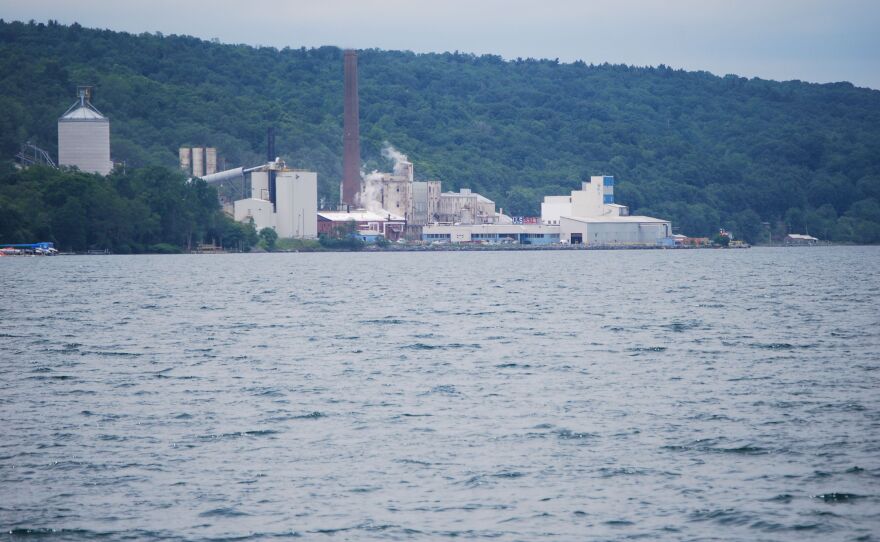It’s something few people think about, but all that natural gas --and other fossil fuels -- produced by hydrofracking has to be stored somewhere before it gets to the consumer. Often used for the job: underground salt caverns like the ones near Watkins Glen in the Finger Lakes. Now an out-of-state company wants to expand storage there, a plan some local residents call risky.
About 100 environmental activists welcomed three of their own with singing that sounded like it was straight out of the civil rights movement last April, after they spent a week in jail.
Ithaca College biologist Sandra Steingraber is the founders of New Yorkers Against Fracking and said after she left jail, “That was really miserable but I’d do it again in a minute.”
The activists landed behind bars after they blocked the entrance to a natural gas facility on the shore of Seneca Lake. It was an act of civil disobedience against plans to store natural gas as well as liquid propane and butane in deep underground salt caverns beside the biggest of the Finger Lakes.
“What’s at stake with the energy facility on Seneca Lake is how we use the land and for what purpose,” said Steingraber.
Though some is already stored in the caverns, Steingraber says the new plan poses dangerous risks.
We’re drawing a line in the sand. This is our home, this is where our children live, and this water and this food becomes the blood and bodies of our kids, and we as parents and residents, it’s our job, it’s our obligation to protect this, what we love we must protect,” she said.
An ancient sea once covered this area, and it left behind shale packed with natural gas, and a thin band of salt. The salt’s been mined since the late 1800s and the emptied out caverns make good places to store the gas and other fossil fuels. A Kansas City company called Inergy bought the mining operation and has applied to the state and federal governments to expand some caverns for storage. It wants to turn this site into a fuel distribution hub for the Northeast.
Opponents like Joseph Campbell of Gas Free Seneca say that will industrialize the region.
“This isn’t just a hole in the ground they’re going to pump gas into. There’s a whole lot that goes with it,” said Campbel..
Things like a six-track rail siding that can load 24 cars every 12 hours, a depot to handle 45 trucks a day, two large brine pits, compressors and a 60-foot flare stack.
Campbell and others say these will wreck a growing tourism economy.
Lou Damiani runs one of the 34 wineries now clustered around Seneca Lake. He says the climate and soils here can make the Finger Lakes a world-class wine region.
We have to understand what our priorities are,” said Damiani. “We’re really on the verge of breaking into something absolutely beautiful that’s sustainable, renewable, that we can hand to future generations.”
More than 150 local business owners have signed a petition opposing the storage plans.
But Jim Franzese is not one of them.
If anybody should be concerned it would be me,” says Franzese.
He owns a bed and breakfast and a small motel right next to the salt plant and existing storage site, but he’s confident state regulations will keep the proposed facilities safe.
“They’ve been storing gas right up the street from me for years and years and years, since I was a kid, and we’ve never had any troubles, so I just don’t think it’s a major deal,” said Franzese.
The project is expected to create 50 short-term construction jobs and 8 to 10 full time positions. But the biggest economic impact will come from a substantial increase in Inergy’s tax payments, says Dennis Fagan, the chairman of the legislature in Schyuler County, where the plant is located. Fagan says a vocal opposition has silenced the majority.
“I consider the people at Gas Free Seneca to be environmental bullies. I don’t believe they are basing their opposition on fact or science,” said Fagan.
The state geologist in New York supports the plan. But Professor John Halfman of the Finger Lakes Institute at Hobart and William Smith College worries that using the caverns for storage could threaten the drinking supply of almost 100 thousand people. He says the lake is unusually salty, possibly because of salt mining.
“I think if they re-utilize the caverns that are down there, it’s going to put pressure on the formation that’s down there and put more salt into the lake. And if we get more salt into the lake, it’s potentially possible to have salt concentrations above what we could use for drinking water,” said Halfman.
No one from Inergy was available to be interviewed for this story, despite repeated requests. But in an e-mail, the company said its facilities are proven to achieve the highest level of safety, environmental stewardship and regulatory compliance.
Both FERC, the Federal Energy Regulatory Commission, and the New York Department of Environmental Conservation are studying public comments before issuing their decisions.
David Chanatry reported this story as part of the New York Reporting Project at Utica College. You can read more of the project's storiesat their website, nyrp-uc.org.







